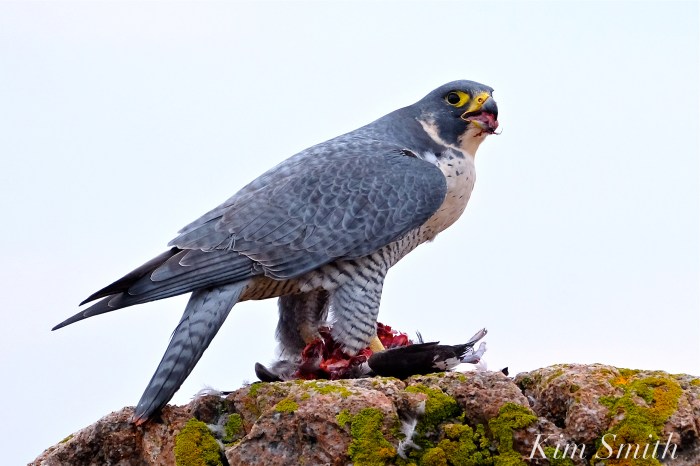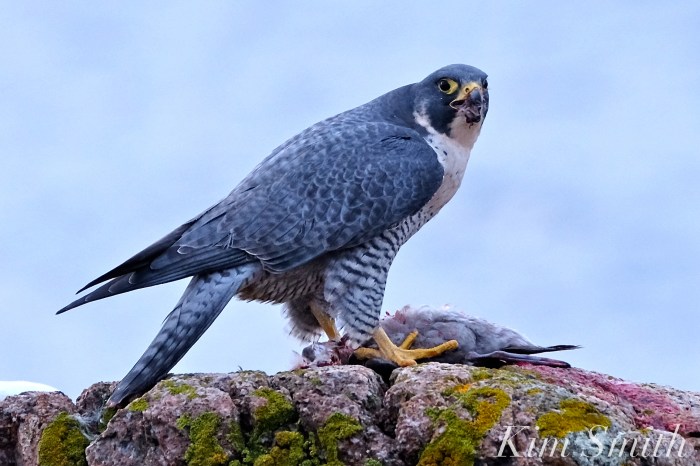 On the lookout for Snowy Owls, I instead encountered this scene of a Peregrine Falcon eating a freshly killed bird. At one point I caught a quick glimpse of what I think was a webbed duck foot, but could possibly also have been a cormorant. Despite all the gore, the Falcon was exquisite to observe. Especially beautiful were the hues of its slate blue wings in the early morning light.
On the lookout for Snowy Owls, I instead encountered this scene of a Peregrine Falcon eating a freshly killed bird. At one point I caught a quick glimpse of what I think was a webbed duck foot, but could possibly also have been a cormorant. Despite all the gore, the Falcon was exquisite to observe. Especially beautiful were the hues of its slate blue wings in the early morning light.
Peregrine Falcons eat mostly birds. Over 450 species of bird prey have been documented in North America alone. From the tinniest Ruby-throated Hummingbird to the enormous Sand Hill Crane, few birds are safe from the talons of the Peregrine Falcon.
The Falcon methodically eviscerated its prey, all the while watching gulls, crows, me, and any other potential thief.
 Robber crows stopped by to see what they could snatch and one brazen fellow made off with a gizzard dangling from its mouth.
Robber crows stopped by to see what they could snatch and one brazen fellow made off with a gizzard dangling from its mouth.
 A gull popped its head up from a lower rock outcropping to see what he could steal and after taking a quick look at the Peregrine Powerhouse, thought better of attempting robbery.
A gull popped its head up from a lower rock outcropping to see what he could steal and after taking a quick look at the Peregrine Powerhouse, thought better of attempting robbery.
Nature’s Finest Flyer
Did you know that the Peregrine Falcon is the world’s fastest bird? A bird’s airspeed velocity is variable. During a hunting dive the Peregrine Falcon will average about 200 miles per hour; 242 miles per hour is the maximum speed recorded. The Golden Eagle is the second fastest bird, with an average diving speed of 150 miles per hour and a maximum speed of 200 mph.
Saved from the Brink of Extinction
Excerpted from The Nature Conservancy
Peregrines are fast, aggressive creatures and are on top of their food chain. While young Peregrines are preyed upon by Golden Eagle and Great Horned Owls there are few threats towards the adults other than man.
By the mid 1960’s, there were NO Peregrines in the eastern United States and the decline spread westwards so that by the mid-70’s western populations had declined by up to 90 percent. It was estimated that 3,875 nesting pairs were found in North America prior to the 40’s; by 1975, only 324 pair existed in the US. Loss of habitat, shootings, egg collecting and other human disturbances had weakened North American populations for decades but drastic declines didn’t occur until after the widespread use of a popular insecticide – DDT. Like the canary in the coalmine, the Peregrine Falcon provided humans a warning as how chemical pollution can disrupt the environment and the life around it.
The use of dichlorodiphenyltrichloroethane, or DDT, began during World War II as an extremely effective pesticide. Its use continued after the war as a way to control agricultural pests and in killing malaria-carrying mosquitoes. Unfortunately it would be years later before it was understood that DDT would have adverse effects on a variety of ecologically important insects, birds, and the environment. Bats, Fireflies and Peregrine Falcons were just a few species that were greatly affected. Editor’s note: In the United States, DDT was manufactured by some 15 companies, including Monsanto, Ciba, Montrose Chemical Company, Pennwalt, and Velsicol Chemical Corporation.
For the Peregrine Falcon, DDT poisoning was due to its being on top of the food chain. After consuming other birds that fed on seeds, insects and fish contaminated with DDT, the poison eventually accumulated in its system. High concentrations of a DDT metabolite called DDE prevented normal calcium production causing thin, frail eggshells that would break under the weight of the parent during incubation. Because of the toxic contaminant, many eggs did not hatch and the populations precipitously dropped until a mere 12% of normal peregrine falcon populations remained in the United States.
In 1970, the American Peregrine Falcon was listed as endangered under the Endangered Species Conservation Act of 1969 (and then again in 1973 when the Endangered Species Act passed). Encouraged by the EPA’s banning of DDT in 1972, recovery projects began to take shape. Beginning in 1974, The Peregrine Fund, along with various national and state agencies in both the United States and Canada, embarked on a reintroduction program for the peregrine falcon.
Thanks to the scientists and researchers at Cornell University, adult birds were successfully bred in captivity. After the eggs hatched, they were raised in the labs until three weeks old. They were then placed in hack sites (artificial nesting sites) where they were fed and cared for by unseen benefactors until flight and hunting skills were developed enough for them to become independent. More than 6,000 American Peregrine Falcons have been released in North America since 1974 due to the cooperative efforts among federal and state Fish & Wildlife Services, The Peregrine Fund, Midwestern Peregrine Falcon Restoration Project and the Santa Cruz Predatory Bird Research Group.
The success of these recovery programs allowed the declassification of the Peregrine Falcon as a federally endangered species in 1999. Although the bird of prey remains federally protected under the Migratory Bird Treaty Act and will be monitored until 2015, the survival of the Peregrine Falcon marked the most dramatic success of the Endangered Species Act.








Hahahahahaha! I love the nosy gull and crow too! (Poor dove)
LikeLiked by 1 person
Love that word nosy; haven’t heard it used for some time, but very apt Jodi!
LikeLike
Scrolled quickly through the devouring bits BUT this is a most beautiful bird. WOW Kim you are sooooo in the right place at the right time. Hmmm, no…in the right places ALL the time! Thank you.
LikeLiked by 1 person
Thank you Lois–always have my camera at the ready ❤
LikeLike